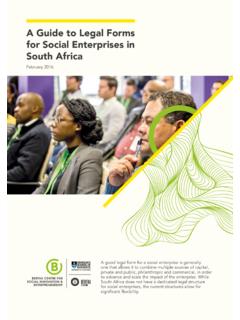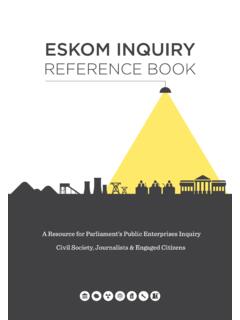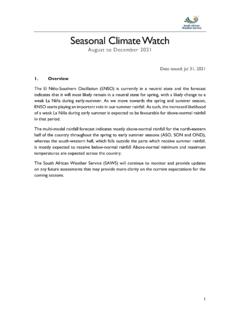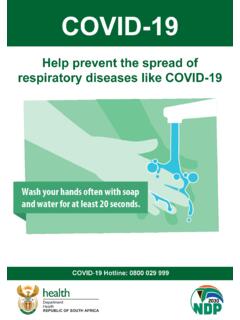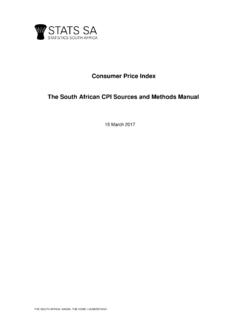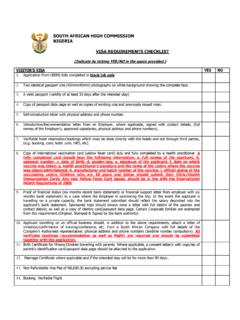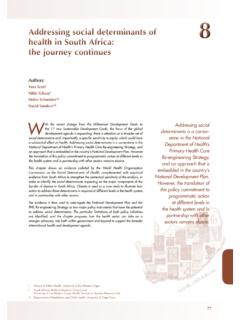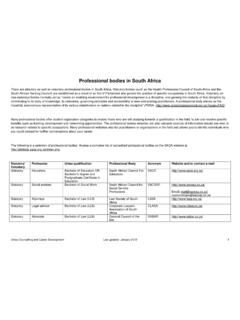Transcription of THE SOUTH AFRICAN RENEWABLE ENERGY IPP …
1 Anton Eberhard and Raine NaudeReview, Lessons Learned & Proposals to Reduce Transaction CostsTHE SOUTH AFRICAN RENEWABLE ENERGY IPP PROCUREMENT PROGRAMMEThis work has been made possible by the generous support of the Royal Norwegian Embassy in SOUTH Africa. We would also like to acknowledge the support of the British High Commission's Prosperity Fund during the initial stages of this | Page Abstract The SOUTH AFRICAN RENEWABLE ENERGY Independent Power Producer Procurement Programme (REIPPPPP) is a competitive tender process that was designed to facilitate private sector investment into grid-connected RENEWABLE ENERGY (RE) generation in SOUTH Africa.
2 Part A of this report serves as a comprehensive handbook of the REIPPPP's design, implementation and outcomes to date. As a result of this programme, SOUTH Africa has achieved more investment via Independent Power Producers (IPPs) in four years than in the rest of Sub-Saharan Africa over the past two decades. Bid tariffs have fallen sharply over the course of the programme and most recently awarded projects are now amongst the lowest priced grid-connected RE projects in the world. Now considered one of the top ten RE programmes globally, the REIPPPP offers valuable lessons for other developing countries in terms of designing and running competitive tenders for grid-connected RENEWABLE ENERGY IPPs.
3 Part B of this report extracts these lessons, bearing in mind that not all are replicable in the different contexts of various AFRICAN countries. Despite the REIPPPP's unquestionable success, a much-discussed shortcoming has been the associated high transaction costs for participating bidders, where this encompasses all costs incurred in bid development and up to commercial operation date. While RE competitive tenders are typically more complex and thus more expensive for IPPs than the common alternative, feed-in tariff programmes, the REIPPPP imposed particularly stringent requirements on bidders.
4 Transaction costs contribute far less to bid tariff, and ultimately to the host government/ buyer's cost of purchasing this power, than factors such as the project's cost of equipment and the cost of capital (financing). However, they are more heavily influenced by tender design, and a competitive tender that reduces this burden to bidders is beneficial both in terms of stimulating competition (by reducing the irrecoverable loss in the event of an unsuccessful bid) and shaving bid tariffs. An improved perception of the risk-return trade-off is particularly important in AFRICAN countries that have a less developed grid than SOUTH Africa and would tender much smaller projects.
5 Part C provides design proposals for reducing these transaction costs. ii | Page Table of Contents Abstract .. i Table of Contents .. ii Acronyms .. iv List of Figures .. v List of Tables .. vi PART A: Review of the SOUTH AFRICAN RENEWABLE ENERGY Independent Power Producer Programme (REIPPPP) .. 1 Section 1: Overview of the REIPPPP .. 1 Section 2: Procurement Design and Requirements .. 3 General requirements (Part A of the RFP) .. 5 Qualification Criteria (Part B of the RFP) .. 10 Evaluation Criteria (Part C of the RFP) .. 23 Legal Contracts .. 26 Section 3: Outcomes of the REIPPPP, Bid Windows 1 to 4.
6 27 Capacity and Project Investment Outcomes .. 27 ENERGY Price Outcomes .. 30 Investment outcomes .. 33 Economic Development Outcomes .. 38 Section 4: The Small Projects IPP Procurement Programme .. 42 Overview of the Small Projects IPP Procurement Programme .. 42 Key features of the SP-IPPPP .. 44 Outcomes of the SP-IPPPP .. 53 PART B: Lessons learned from the SOUTH AFRICAN REIPPPP .. 55 Section 1: Overview of the REIPPPP s success to date .. 55 Section 2: Key Lessons from the REIPPPP's success .. 56 Enabling policy and regulatory environment.
7 56 Mandated, authorized and coordinated leadership .. 62 Adequate resources for hiring experienced transaction advisors .. 67 Auction Design Built on International Best Practice .. 69 High quality, bankable documentation and contracts .. 78 Fairness, transparency and trust building with the private sector .. 89 Capital markets that provide adequate and competitively priced funding .. 90 Maintain credibility of the procurement programme .. 91 Grid connection .. 91 iii | Page Part C: Reducing Transaction Costs .. 93 Section 1: Introduction.
8 93 Capital Costs .. 94 Cost of Capital (Discount Rate) .. 97 Operations & Maintenance Costs .. 98 Capacity factor .. 98 Section 2: Tender Design and Reducing Transaction Costs .. 99 Conclusion .. 107 Appendices .. 108 Appendix 1: Project Outcomes by Geography and Technology .. 108 Appendix 2: Detailed Economic Development Criteria and Associated Outcomes .. 109 Job Creation .. 109 Local Content .. 111 Ownership .. 114 Management Control .. 117 Preferential Procurement .. 117 Enterprise Development .. 118 Socio-Economic Development .. 119 Appendix 3: Geographical spread of and additional details on SP-IPPPP awarded projects.
9 121 Appendix 4: PPA Key Clauses .. 122 iv | Page Acronyms BEE Black Economic Empowerment B-BBEE Broad-Based Black Economic Empowerment BW Bid Window CA Connection Agreement CSL Contributor Status Level CSP Concentrated Solar Power DA Direct Agreement DEA Department of Environmental Affairs DFI Development Finance Institution DOE Department of ENERGY DWA Department of Water Affairs EPC Engineering, Procurement & Construction FC Financial Close IA Implementation Agreement IPP Independent Power Producer LFG Landfill Gas MW(h) Megawatt (hours) NEMA National Environmental Management Act (of SOUTH Africa) NERSA National ENERGY Regulator of SOUTH Africa OM Operations & Maintenance PPA Power Purchase Agreement PPP Public Private Partnership PV Photovoltaic RE RENEWABLE ENERGY REIPPPP RENEWABLE ENERGY Independent Power Producer Procurement Programme RFP Request for Proposal SA SOUTH Africa(n) SP-IPPPP Small Projects Independent Power Producer Procurement Programme SPV Special Purpose Vehicle v | Page List of Figures Figure 1: REIPPPP Tender Process Timeline.
10 3 Figure 2: Hourly Solar PV and Wind Production Profiles for all 31 days of January 2015 & Average System Load Diurnal Course .. 29 Figure 3: Weighted Average Bid Tariff (across all selected projects) per Bid Window .. 30 Figure 4: Corporate finance vs. Project finance per Bid Window .. 33 Figure 5: Major Equity Providers in the REIPPPP by number of projects (BWs 1 to 4) .. 35 Figure 6: Major Debt Providers in the REIPPPP (based on number of projects for which debt funding was made available, based on data from IPP office bid submission documents) .. 36 Figure 7: Total funding per lender category (ZAR m) and percentage contribution to total debt funding - BWs 1 to 4 (based on data in submitted bids from IPP office) 37.

